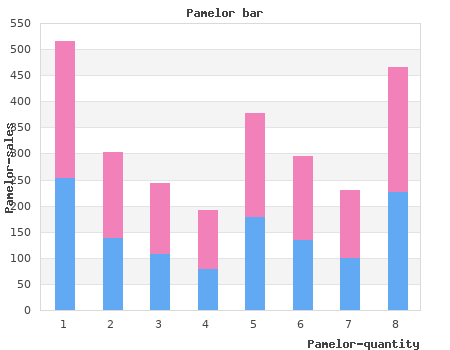By R. Thorek. Montclair State University. 2017.
Then order 25 mg pamelor with visa, you would release the fluid and tap the medial aspect of the knee order pamelor 25 mg overnight delivery. In the next few seconds, if an effusion is present, then the fluid will redistribute laterally and a fullness will develop on the lateral side of the knee. The Lachman test is performed by flexing the patient’s knee to 20° and sta- bilizing the patient’s femur with one hand and pulling the tibia toward you with the other hand. This is important because a few degrees of anterior glide of the tibia on the femur may be normal. The anterior drawer test is a similar test that should also be per- formed to evaluate for an ACL injury. In this test, the patient’s knee is flexed to 90° with the feet flat on the table. The examiner sits on the patient’s foot to stabilize it, and with the examiner’s hands cupped around the back of the patient’s upper calf, the tibia is pulled toward the examiner (Photo 7). If the tibia slides forward from under the femur more than a few degrees, there may be a tear in the ACL. If the patient has a positive anterior drawer sign or Lachman test, repeat the maneuver with the patient’s leg in external and internal rota- tion. Repeating the maneuver with the leg in external rotation should tighten the posteromedial portion of the capsule. If the patient’s tibia glides forward as much as it did with the leg in the neutral position, an MCL tear may be accompanying the potential ACL tear. Repeating the test with the leg in internal rotation tightens the posterolateral capsule. If the patient’s tibia again glides forward as much as it did with the leg in the neutral position, an LCL tear may be accompanying the poten- tial ACL tear. To test for a posterior cruciate ligament (PCL) tear, the examiner stays seated on the patient’s foot as for the anterior drawer test. However, instead of pulling the patient’s tibia toward the examiner, the tibia is pushed posteriorly (Photo 8). If the patient’s tibia glides posteriorly on the femur, it is likely torn, although the PCL is rarely torn.
Although laboratory studies suggest that psy- chological interventions can be effective for reducing acute pain order pamelor 25mg with mastercard, they may tell little about whether these interventions will be effective in the clinical context due to the limited generalizability of laboratory analog studies discount pamelor 25 mg free shipping. Se- lection of interventions for use in the clinical environment should therefore be based primarily on results of clinical trials. Clinical Trials in Adults Empirically supported generalizations regarding the efficacy of specific psy- chological interventions for clinical acute pain are made difficult by the number of different techniques used alone or in a variety of combinations, the multitude of clinical acute pain stimuli differing substantially in inten- sity, and the relatively small number of studies examining any one tech- nique for use with any given type of clinical situation. For these and a vari- ety of methodological reasons, truly integrative reviews of the clinical literature have been limited. For example, a qualitative review of random- ized controlled trials (RCTs) of relaxation techniques (limited to those stud- ies in which relaxation was not combined with other techniques) for use in postsurgical and procedural acute pain settings identified only seven such studies that reported on pain outcomes (Seers & Carroll, 1998). An equal number of studies were found that reported only on distress-related out- comes, which do not necessarily correspond directly with pain outcomes 252 BRUEHL AND CHUNG (Seers & Carroll, 1998). Results of this review indicated only weak evidence for efficacy of relaxation techniques in such settings, with only three of seven studies detecting significant pain-reducing effects of relaxation train- ing (Seers & Carroll, 1998). Negative results do not appear to be unique to relaxation interventions, given that work examining combined interven- tions incorporating relaxation, distraction, and imagery (for knee arthro- gram pain) has also described negative results (Tan & Poser, 1982). An im- portant conclusion drawn from the review by Seers and Carroll (1998) is that small sample sizes are a common problem in relaxation-related RCTs, a conclusion that aptly describes the broader literature on psychological in- terventions as well. Therefore, lack of statistical power may often account for the negative results obtained. Despite findings such as those just de- scribed that might suggest that psychological interventions for acute pain are of questionable efficacy, other RCTs suggest that psychological inter- ventions may be useful for some types of acute clinical pain. Results of sev- eral RCTs are next reviewed, organized by type of clinical setting. Labor Pain One of the earliest clinical applications of psychologically based inter- ventions for acute pain was the use of the Lamaze technique for labor pain. The Lamaze approach incorporates elements of sensory and procedural in- formation provision in addition to training in controlled breathing for pur- poses of relaxation and distraction.

Flexion or extension con- tractures or combinations of the two may be present buy cheap pamelor 25mg. The extremities appear cylindrical as a result of the defective muscle formation order pamelor 25 mg mastercard, giving the infant the appearance of If the muscles didn’t grow independently (by means of a separate a stuffed doll. The normal skin wrinkles are missing, growth organ), but were only passively »stretched« by the lengthening although sensation remains intact. In terms of etiology, there is no underlying involvement is common, and these patients with poorly uniform clinical entity. The complex of symptoms can functioning hands and feet generally have good trunk also occur in association with various known disorders muscles. Möbius syndrome, Kniest syndrome, producing a picture reminiscent of clubfoot (⊡ Fig. Pierre-Robin syndrome, myelomeningoceles, congenital Tarsal coalitions may also be present concurrently. A hereditary component is not in- Flexion and extension contractures are observed at volved in most cases. A muscle, and possible nerve throgryposis in English-speaking countries in the 1960’s biopsy can be useful in identifying the primarily dam- may have been triggered by a virus. From the orthopaedic standpoint, the skeletal esis can prevent the normal development of muscle tissue. The hips are very often affected (in 80% of fail to form or if disorders interfere with endplate function cases) [1, 44], the knees and feet [22, 37] to a lesser or the muscles themselves. Investigation of the hips, by ultrasound at birth ment just at the time in embryogenesis when the joints and subsequently by radiographic methods or MRI, is are developing. Although the causes of the lack of movement are var- If clinically visible deformities of the knees are present ied, the response of the body is uniform: the formation of (and to a lesser extent the feet) imaging procedures can extra connective tissue in the muscles and joint capsules. Fractures or epiphyseal separa- a neurogenic cause was found in 93% of cases, while the tions often occur at birth, most often in the vicinity of the cause was myogenic in just 7% of cases. Treatment, prognosis Normal muscles appear to possess a kind of growth The progression depends on the underlying disorders.

Small deep–partial and full-thickness burns in patients who continue work- ing and attending school are best treated conservatively and operated on as out patients procedures purchase 25 mg pamelor with mastercard. Burns to the hands and feet benefit from an aggressive approach to permit the patient’s early social and work reintegration PREPARATION FOR SURGERY Burn surgery requires commitment and cooperation from the whole burn team discount 25 mg pamelor with amex. Treatment of massive burns is an enterprise that matches the complexity of open- heart surgery or any other major surgical procedures based on the interaction of a multidisciplinary team. It should be only attempted in major tertiary hospital facilities where the whole spectrum of specialization is available. Even though burn wound excision and grafting may seem to the novice as a simple and easy surgical procedure, a profound understanding of the burn pathophysiology, dy- namics of wounds, critical care, and wound healing is necessary to perform suc- cessful operations. Burn wound excision, either immediate/early or delayed should be considered an elective procedure and prepared and managed as such. Only emergency surgi- cal airway access and escharotomy and fasciotomy should be undertaken without formal and proper evaluation. Experienced burn anesthetists and burn surgeons only should perform burn wound excision, since minor errors may lead result in the death of patients. Anesthetic Evaluation Destruction of skin by thermal injury disrupts the vital functions of the largest organ in the body and results in a systemic inflammatory response that alters function in virtually all organ systems. All changes that occur during the resuscitation phase and postresuscitation phase should be noted and taken into account to provide safe anesthesia. Treatment of burn patients must compensate for loss of these func- tions, until the wounds are covered and healed. Preoperative evaluation of the burned patient is guided largely by knowledge of these pathophysiological changes. Good communication with the surgical team is essential in order to estimate the size and depth of the wound to be operated on. This will help in estimating the actual physiological insult to be expected during surgery. The trauma that surgery superimposes on the already increased metabolic rate of burn patients can result in it being impossible to ventilate patients during surgery.
Setty buy pamelor 25 mg with visa, MD generic 25 mg pamelor with amex, Senior Resident, Anesthesiology, Johns Hopkins Hospital, Baltimore, Maryland Maneesh Sharma, MD, Fellow, Pain Medicine, Johns Hopkins University Hospital, Baltimore, Maryland Michael T. Smith, PhD, Assistant Professor, Department of Psychiatry and Behavioral Sciences, Johns Hopkins University School of Medicine, Baltimore, Maryland Linda S. Sorkin, PhD, Department of Anesthesiology, University of California, San Diego, La Jolla, California Kevin Sperber, MD, Clinical Instructor, New York University School of Medicine; Director of Inpatient Services, Comprehensive Pain Treatment Center, Hospital for Joint Diseases, New York City, New York Peter S. Staats, MD, MBA, Associate Professor, Division of Pain Medicine, Department of Anesthesiology and Critical Care Medicine and Department of Oncology, Johns Hopkins University, Baltimore, Maryland Michael Stanton-Hicks, MB, BS, Division of Pain Medicine, Department of Anesthesia, Cleveland Clinic Foundation, Cleveland, Ohio Michelle Stern, MD, Assistant Clinical Professor of Physical Medicine and Rehabilitation, Columbia University College of Physicians and Surgeons, New York Presbyterian Hospital, New York City, New York Richard L. Stieg, MD, MHS, Associate Clinical Professor of Neurology, University of Colorado Health Sciences Center, Denver, Colorado William Tontz, Jr. Viesca, MD, Texas Tech University Health Service Center, Lubbock, Texas Christopher M. Viscomi, MD, Department of Anesthesiology, University of Vermont College of Medicine, Burlington, Vermont Eugene R. Viscusi, MD, Thomas Jefferson University Hospital, Department of Anesthesiology, Philadelphia, Pennsylvania Mark S. Wallace, MD, Program Director, Center for Pain and Palliative Medicine, University of California, San Diego, La Jolla, California Bradley W. Wargo, DO, Pain Management Fellow, Cancer Pain Management Section, University of Texas MD Anderson Cancer Center, Houston, Texas Christopher L. Wu, MD, Associate Professor of Anesthesiology, Director, Regional Anesthesia, Johns Hopkins University Hospital, Baltimore, Maryland Tony L. Yaksh, PhD, Department of Anesthesiology, School of Medicine, University of California, San Diego, La Jolla, California This page intentionally left blank. FOREWORD This concise volume, edited by two of today’s leading pain clinician-scien- tists, represents the culmination of several forces.




